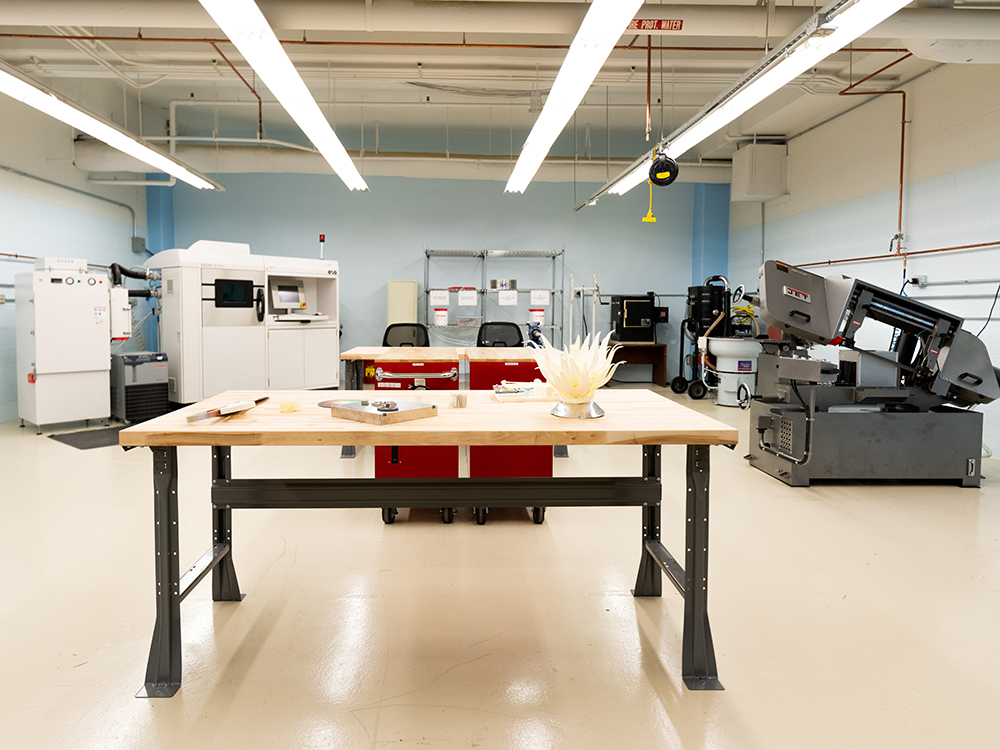March 5 marked the opening of the new Center for Additive Manufacturing and Design Innovation in the Cockrell School of Engineering. The 3,000-square-foot facility features more than $1.5 million worth of commercial-grade machines that can print complex parts used in a variety of fields, including medical research, aerospace, energy, robotics and more.
The facility will boost the Cockrell School's research capabilities in additive manufacturing, the technical term for 3D printing preferred by those in the field. The center is also launching an industry affiliates membership program where researchers will team up with companies with an eye toward advancing what can be done in additive manufacturing.
"We are interested in working with partners who want to push the envelope of what we can print — creating new materials, designing new processes and R&D applications that move the technology forward," said Carolyn Seepersad, director of the center and professor in the Walker Department of Mechanical Engineering.
A virtual ribbon-cutting ceremony on March 5 commemorated the opening of the new facility, and a panel discussion on the state of additive manufacturing featured local leaders in the industry, including David K. Leigh, CTO of EOS; Kent Firestone, former CEO of Stratasys Direct Manufacturing and current senior vice president of operations for EOS; Vikram Devarajan, CEO of Evonik subsidiary Structured Polymers; and Samantha Snabes, co-founder and CEO of re:3D.
Austin has become an additive manufacturing hub, due to the presence of leading companies and the prominent role The University of Texas at Austin has played in the industry dating back to its early days. In the future, the panelists expect to see more new facilities pop up both in hotspots and other places that aspire to play a big role in the industry going forward.
Over the years, the big picture goal of additive manufacturing production has shifted from an emphasis on making small machines that anyone could use to focus more on large machines used by companies and other creators. That has also shifted how researchers think about the technology.
Challenges remain to advance the industry further, including a lack of machine consistency from print to print and a need for universal standards. Leigh of EOS thinks that once a primary application is found for additive manufacturing, a lot of these problems will be solved quickly.
“Once we get that killer app, we will figure out how to get machine-to-machine consistency because there will be a monetary incentive to do so,” Leigh said.
Innovation requires massive amounts of experimentation. And before success comes failure. Those failed experiments, from centers like the new one at UT Austin, are important because they eventually lead to breakthroughs. And once those breakthroughs happen, that’s when research collaborates with industry to bring them to life.
“What you provide is a way for everyone to stand shoulder to shoulder to overcome some of these hurdles,” Snabes said of the new center.

Inside the center, there are several labs and state-of-the-art equipment that Cockrell School researchers and industry affiliates will use:
- Machines in the Metal Powder Bed Fusion Lab can create durable metal parts with complicated shapes and structures. Seepersad said these parts can be used in airplanes, to build tools sent downhole when drilling for energy resources or to create surgical screws and other medical solutions such as pads that go in between vertebrae.
- The Liquid Polymer Lab includes machines capable of printing a variety of flexible materials with a range of potential uses. A PolyJet device can create materials that mimic the mechanical function of organs and tissue, which means it can print copies of the anatomy without needing cadaver parts. These materials can be used for surgical practice and robotic surgery, where personnel can say how well machines do operating and then fine-tune them before working on human patients. A stereolithography machine can build highly accurate large polymer parts that can be used in building robots. The device can also print transparent parts, which is important for surgical planning, allowing medical personnel to watch the path instruments take.
- Another series of machines arriving soon at the facility will allow researchers to test the accuracy of print jobs. How well did the parts match up to the CAD file used to create them? Heat maps show where the printing process was most accurate on a specific part and where there were departures from the initial design.
The University of Texas at Austin has a rich history in additive manufacturing, with researchers pioneering a new concept in the field in the 1980s. Selective Laser Sintering — the mechanical process of building objects layer by layer, zapping a paper-thin layer of powder dust with a laser to form 3D objects — was created by mechanical engineering professor Joseph Beaman and his graduate student at the time, Carl Deckard.
At the time, creating objects from 3D-computer designs seemed impossible, but it has become ubiquitous in recent years. Seepersad credits the explosion of additive manufacturing in part to the availability of desktop printers that cost a couple thousand dollars apiece. These devices had a similar effect on additive manufacturing as smaller desktop machines had on computing.
The next step in the evolution of additive manufacturing, Seepersad said, comes with creating new materials and solving design and accuracy challenges. Researchers in the Cockrell School have their eyes on this next frontier, and the new center, along with future industry partners, will go a long way in making that happen.
Watch the recording of the center's March 5 virtual launch event:






